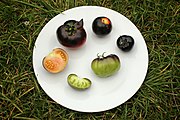
Blue tomatoes, also called purple tomatoes, are tomatoes that have been bred to produce high levels of anthocyanins, a class of pigments responsible for the blue and purple colours of many fruits, including blueberries, blackberries and chokeberries. Anthocyanins may provide protection for the plant against insects, diseases, and ultraviolet radiation. Some of these tomatoes have been commercialized under the names "Indigo Rose" and "SunBlack".

